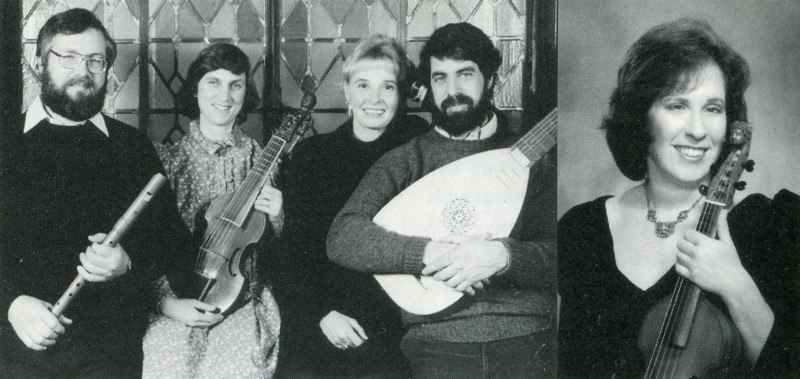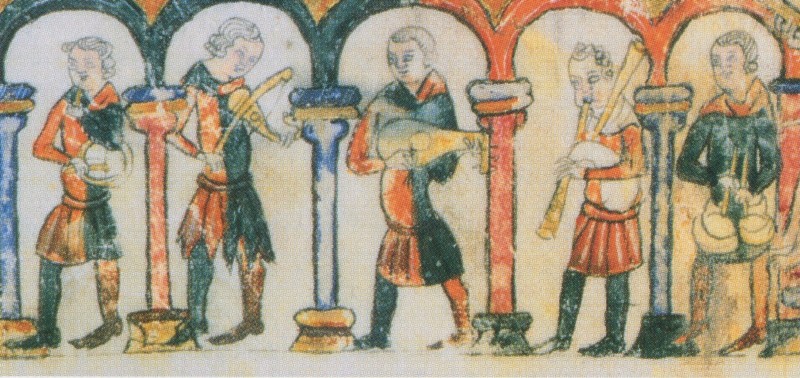Songs of the Sephardim / La Rondinella
Traditional Music of the Spanish Jews

medieval.org
amazon.com
Dorian Discovery DIS-80105
03·09.1990 - 06.1992
Bradley Hill Presbyterian Church, Bethesda, Maryland, USA
01 - Los gayos empesan a cantar [2:20]
02 - Una hija tiene el rey [3:26]
03 - La prima vez [4:07]
04 - Puncha, puncha [1:49]
05 - A'har noghenim [1:48]
06 - Era escuro [2:19]
07 - Seu shearim [1:36]
08 - Esta montana d'enfrente [3:20]
09 - Una pastora [2:11]
10 - Morena me llaman [1:25]
11 - Nani, nani [1:41]
12 - A la una yo naci [2:22]
13 - Scalerica de oro [3:16]
14 - Yo m'enamori [3:20]
15 - Dos amantes tengo la mi mama [2:26]
16 - Una matica de ruda [2:43]
17 - Los bilbilicos [3:23]
18 - Ir me quero [3:31]
19 - Hija mia [2:52]
20 - Durme, durme, hermozo hijico [2:29]
21 - Avre tu puerta cerrada [1:40]
22 - Noches, noches [1:46]
23 - Partos trocados [2:25]
24 - En la mar hay una torre [1:42]
25 - Esta Rachel la estimoza [1:11]
26 - Cuando el rey Nimrod [3:59]
27 - Adio, querida [3:01]
La Rondinella
Alice Kosloski, alto
Paul Bensel, recorder, crumhorn, percussion
Howard Bass, lute, guitar, harp, percussion
Rosalind Brooks Stowe, treble viol, vielle, percussion
Guest artist:
Tina Chancey, treble viol, vielle, rebec, kamenj, recorder,
percussion (#3, 4, 10, 16, 18, 21, 22, 26)

Paul Bensel, Rosalind Brooks Stowe, Alice Kosloski, Howard Bass / Tina
Chancey
THE SONGS ON THIS RECORDING DERIVE FROM a tradition that is centuries
old. Passed down through the generations, these songs are links in a
chain that connects the Jews known as Sephardim to Spain, from which
they were expelled in 1492.
Sepharad is a Hebrew word indicating Spain or the Iberian
Peninsula, where Jewish culture had thrived since the time of the Roman
empire. When the Jews left Spain, only the wealthiest could take their
possessions with them; most people took little more than they could
wear or carry. But the power of King Ferdinand and Queen Isabella could
not strip them of their unwritten culture. The language of many
Sephardim is called Ladino, Judezmo, or Judeo-Spanish. It is in
Ladino that the songs on this recording are sung. This language has
attracted the interest of scholars because it preserves aspects of the
Spanish language as it was spoken in the 15th century. Of course,
Sephardic Jews added words from the new lands they inhabited, and
Hebrew words appear with some frequency. In some countries they adopted
the local language. Overall, however, the language spoken by most
Sephardic Jews has not changed much from the days when Columbus set
sail.
When the Edict of Expulsion was handed down by Ferdinand and Isabella
in March 1492, the Jews of Spain were given four months to prepare for
exile. Thus ended fifteen centuries of Jewish settlement. Jewish
culture flourished in Spain, intellectually, artistically, and
materially. Under Moslem rule especially, Jews had the freedom to
pursue a variety of professions and intellectual pursuits. However, as
the Spanish began to drive out the Moorish rulers, distrust and hatred
of non-Christians increased throughout the land. By the late 14th
century, pogroms, massacres, forced conversions, confiscation of wealth
and property, and increasingly restrictive laws began to affect Jewish
communities throughout Spain. Jews in significant numbers converted to
Catholicism, only to find themselves confronted by the Inquisition,
established in the mid-15th century to seek out and destroy heresy.
Many conversos (converted Jews) were accused of practising
Judaism in secret. Eventually, large numbers of conversos lost their
rights and property. Thousands were humiliated and tortured. Thousands
more were executed.
In early January 1492, the Moors were driven from Granada, their last
stronghold on the Iberian peninsula. The Edict of Expulsion followed in
March. Scholars disagree about how many Jews left Spain; the numbers
range from 50,000 to 300,000. Where they went is easier to determine.
Some simply crossed the border to Portugal, from which they were
subsequently expelled in 1497. Others travelled northward to England
and the Netherlands (at the time ruled by Spain), but many more
dispersed throughout the Mediterranean region. Sephardic communities
were established in North Africa, where they remain to this day. The
Moslem rulers of Tunisia, Algeria, and Morocco continued the
enlightened policy of peaceful coexistence they had practiced on the
Iberian peninsula. Known as convivencia, this policy is still
in effect under 20th-century rulers like King Hassan II of Morocco.
Farther east, the Ottoman Empire was particularly receptive to the
Sephardim, who settled in Turkey, the Balkans, Greece, Egypt, and
Palestine. These communities flourished in relative security until well
into this century. Thousands of Sephardic Jews living in southern
Europe perished in the concentration camps of Hitler's Germany. While
remnants of these communities still exist, many Sephardic Jews
immigrated to North and South America, and, Of course, to Israel.
In exile Sephardic Jews have clung to aspects of their Hispanic
culture, a connection strongly maintained through language. Liturgical
and secular songs played an important role in the preservation of
Ladino, and kept alive memories of historical events that otherwise
might have been forgotten. It may become apparent, as you peruse the
translations of these songs, that many of them express a woman's point
of view. Andrés Bernáldez, a Spanish monk who observed
the exile of Spanish Jews, wrote the following account that highlights
the important historical role that women played in preserving the song
tradition: "They were abandoning the land where they were born. Small
and large, young and old, on foot, atop mules or dragged by wagons,
each one followed his own route toward the chosen port of departure.
They stopped by the side of the road, some collapsing from exhaustion,
others sick, others dying. There was not a person alive who could not
have pity for these unfortunate people. Everywhere along the road they
were begged to receive baptism, but their rabbis told them to refuse, while
urging the women to sing and play tambourines to keep their spirits up."
What you will hear on this recording, therefore, are lullabies, love
songs, and narratives preserved primarily by Sephardic women in lands
throughout the Mediterranean. Women must have composed many of them as
well. Some of the songs refer to historical or Biblical events. "Cuando
el rey Nimrod" deals with the prophecy of the hunter-king who foresaw
the coming of Abraham. "Partos trocados" hints at legends surrounding
the birth of Moses. "Seu shearim," heard here instrumentally, is sung
during the holidays of Simchat Torah and Rosh Hashanah. Most of these
songs, though, are secular love songs and lullabies. The evocative "Dos
amantes tengo la mi mama" is a song of courtship, and "Scalerica de
oro" represents the wedding song tradition, a vital part of the
Sephardic repertoire. Even in a lullaby, though, Jewish elements can
sometimes be detected, as in the song "Durme, durme, hermozo hijico."
The line "You will go to school and study the law" surely refers not to
civil law but to the noble Jewish scholarly pursuit of knowledge of the
Talmud, which contains the laws by which devout Jews must live.
In the early years of the 20th century folklorists and
ethnomusicologists began to seek out and record traditional songs and
tunes of their countrymen: Cecil Sharp in England, Béla
Bartók and Zoltán Kodály in Hungary, John Lomax in
the United States. In Sephardic communities it was Manuel Manrique de
Lara who, between 1911 and 1916, was the first to make an extensive
study of this repertoire. He collected over 2000 texts and 400 tunes,
preserving many songs that might otherwise have disappeared. Many
scholars have followed in Lara's footsteps, and it is from anthologies
published by these collectors that we have developed our arrangements.
As in any folk-song tradition, especially one as widespread as
Sephardic song, there are many variations in tunes and texts. In "Los
bilbilicos cantan," for example, our version uses a Hebrew word, neshama,
soul, where other versions employ the Spanish term, alma. There
were also regional differences in singing styles, and in the manner of
accompaniment. We don't know if instruments were used at all to
accompany the singing prior to 1492, or even in the centuries that
followed. A mother singing a lullaby most likely sang without
instrumental accompaniment. A group of people singing together,
however, probably would have used whatever instruments came to hand,
and would have sung in harmony. Earlier in this century among the
Sephardim of Bosnia, for example, the accordion was very popular. In
Turkey and North Africa, the oud (Arabic cousin of the lute) was likely
to have been used.
We make use of wind instruments, bowed strings, plucked strings, and
percussion to accompany the vocal lines. We have chosen to play some
songs as instrumental pieces. The instruments are mostly ones that
would have been familiar to European people of the 15th and 16th
centuries. The wind instrument family is represented by recorders
ranging in size from the soprano to bass, and by the crumhorn (heard on
"Esta Rachel" and "Scalerica de oro"). The crumhorn is a capped, double
reed instrument that falls into the category known among early
musicians as "the buzzies." The bowed strings heard here are the treble
viol, a common court instrument of the high Renaissance, and its
medieval counterparts, the vielle ("Ir me quero") and the rebec
("Puncha, puncha" and "Una matica de ruda"). The most unusual bowed
string is the kamenj, a slender, box-shaped instrument with four
strings. This sort of instrument was known in the ancient Islamic world
and also in the Black Sea and Balkan regions. Its nasal sound can be
heard on "La prima vez" and "Noches, noches." The lute, one of the most
popular instruments of the 16th century, is featured on "Una pastora"
and "Ir me quero," and it shares about equal time with a standard,
nylon string classical guitar for the accompaniments. A small, lap-held
Gothic harp, medieval descendent of King David's version, was used in
"Esta montaña" and "Partos trocados."
Whether any of the songs on this recording date from the time when Jews
lived freely in Spain is unknown. Nor can anyone say with certainty how
Spanish Jews performed their songs. Sephardic music has joined the
"singing stream" of folk tradition, and folk music is not static,
especially one preserved for so many centuries and in so many lands.
The five hundredth anniversary of the expulsion has brought new
attention to Sephardic song and, like many early music ensembles, our
imagination has been fired by this exquisite music. Plucked and bowed
strings, recorders, and percussion instruments like the ones we use
were part of the musical heritage on the Iberian Peninsula, in the
royal courts and among common people. It seems at least possible that
they were used in Jewish communities as they were in the courts of
Spanish nobility. We hope that the interpretations offered here reflect
something of the spirit that has sustained Sephardic communities and
kept this tradition alive for more than half a millennium.
— Howard Bass



